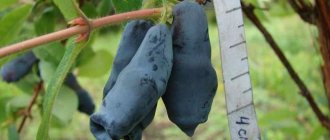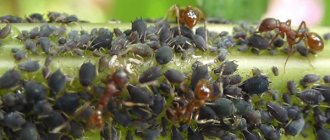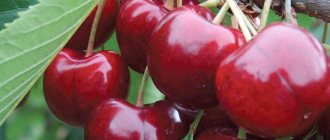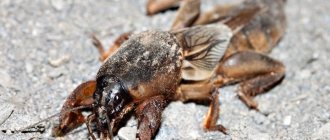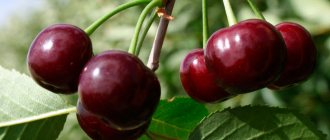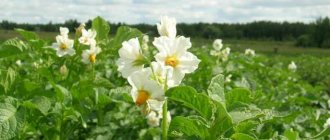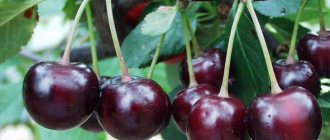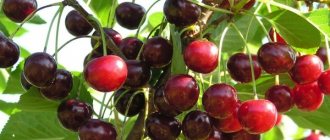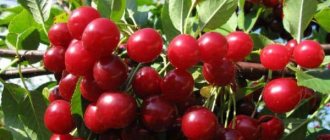History of the variety's creation
This cherry variety was bred by Saratov breeders Kruglova, Dymnova and Kaverin, who worked at the Saratov Experimental Horticulture Station at the end of the last century. After the tests, the variety was included in the State Register of Russia in 1995. Malyshka cherry is recommended for cultivation in the Lower Volga region.
This cherry is a hybrid and was obtained by crossing the Early cherry and Duke 1-2-29.
Interesting!
Duke is a hybrid obtained by crossing cherry and sweet cherry varieties. This hybrid has the main characteristics and properties taken from both parent varieties, but Duke is still closer to cherry.
Although the name of this variety “Saratovskaya Malyshka” is included in the State Register, among gardeners this cherry variety is affectionately called simply “Baby”.
Description of the Saratov baby cherry - video
Features of fruiting
The Saratov Malyshka cherry variety is distinguished by early fruiting and begins to bear fruit already 3–4 years after planting.
Flowering begins in mid-May. Harvest ripening occurs in the third decade of June. The fruits ripen at the same time. From one mature tree you can collect up to 15 kg of berries.
The average yield from one tree is 12–14 kg of fruits
Features of storage and use
In the refrigerator, fresh fruits without dents or other damage retain their appearance and taste for up to 10 days. Dry, unwashed berries are placed in a clean plastic bag and tied.
In addition, there are two ways to freeze cherries in the freezer (with and without pits). You can also dry cherries in the oven without pits at a temperature no higher than 55–60 degrees. Ready dried cherries are stored in tightly closed glass jars or any other sealed containers.
Properly frozen and dried cherries do not lose their beneficial properties and are used for making drinks, compotes, jams, fruit drinks and wines, decorating baked goods and ice cream. Fresh cherries are suitable for direct consumption, as well as for making jam, purees, juices, etc.
The Saratov Malyshka cherry variety is great for preparing various preparations for the winter.
Main characteristics and description of the variety
The Malyshka cherry hybrid received many positive qualities from its “parents,” including high resistance to cold, good yield and excellent taste of ripe berries.
This tree has a small height - up to 2.5 m, the crown is spherical, compact, slightly spreading. Cherry Baby grows quite quickly.
The trunk is medium in size with smooth brown bark. The branches are thick, arched. The wood of the trunk and flower buds are highly resistant to cold. The shoots are well leafed. The foliage is large, slightly concave, with a smooth leaf blade, dark emerald in color.
Cherry Baby - photo
The flowers are small in size, with white petals. The Malyshka cherry begins to bloom in the second ten days of May. Mostly flowering occurs on bouquet branches.
The berries of this cherry are round, slightly flattened, weighing about 5 g. The skin is medium in thickness, dark red in color, smooth, shiny. The pulp is juicy and tasty, dark red in color.
The fruits contain:
- 7.5% sugars;
- 1.2% acid;
- vitamin C per 100 g of product – 8 mg.
On a note!
Tasters rated the taste of ripe Malyshka cherries as 4.4 points.
The variety is considered a table variety.
Reviews from gardeners about the Saratov baby cherry
I have two dukes - Spartanka and Malyshka (most likely Saratov Malyshka). Both are growing normally and have not frozen. Spartan has wider legs, Baby is thicker. Until this year there were only sporadic flowers. Both were surprised this year. Firstly, they bloomed with a difference of a week and a half (Spartanka was much later; practically no one bloomed nearby). The baby, apparently, was perfectly pollinated by someone - unlike all my cherries, it was simply hung with berries. The berries, like large sweet cherries, ripened very early - in July. Overall, I really liked it!
Lena K.
https://forum.tvoysad.ru/plodovye-derevya-f30/dyuki-vishne-chereshnevye-gibridy-t107–105.html
I have a Duke Saratovskaya Malyshka, which I am happy with. The variety is really small in size, compact, with large tasty fruits. It is the earliest ripening, but it is more susceptible to coccomycosis than others and requires increased attention in this regard.
Apple
https://forum.vinograd.info/showthread.php?t=351&page=248
Saratov baby is a cherry-cherry hybrid that is suitable for growing in private plots and on fruit and berry plantations for commercial breeding. Unpretentiousness in care, early fruiting and early ripening of berries, resistance to drought, frost and disease, combined with high fruit yield make the variety especially popular
- Author: Vita Gornaya
Rate this article:
- 5
- 4
- 3
- 2
- 1
(4 votes, average: 4.8 out of 5)
Share with your friends!
Pollinator trees
The Malyshka cherry variety is self-sterile, so pollinating trees with similar flowering periods must be planted nearby.
The best pollinators for the Malyshka cherry are the following varieties:
- Lyubskaya;
- Turgenevka;
- Youth;
- Nord Star.
Reviews
Nikolai.
Hello cherry connoisseurs. The Malyshka variety grows on my plot. Very large and very tasty berries. Ripens early, at the same time as cherries. With respect, Nicholai.
Elena.
I'm completely satisfied with this variety. Yes, cherries are not self-pollinating, but this is an incentive to plant several more trees. In addition, the bushes are compact, you can plant several in a small area. The berry is large and sweet, which is not typical for dwarf trees. In general, I recommend this variety to everyone.
Cherry yield Baby
Cherry Malyshka is an early ripening variety - the first harvest from compact trees is harvested 3-4 seasons after the seedlings are planted in a permanent place.
Photo of cherry Malyshka
The fruits begin to ripen in the third decade of June. The average yield of an adult cherry is 14-16 kg, but with good care and timely feeding, the yield of the Malyshka variety can reach 20 kg.
Characteristics
The characteristics of the Malyshka cherry variety make it indispensable for small private gardens located in the central part of Russia. This cultivar has been grown in household plots for more than 20 years, and has earned excellent reviews.
Drought resistance, winter hardiness
The drought resistance of the Saratovskaya Malyshka variety is good; an adult tree needs to be watered only in the absence of rain for a long time. In the Lower Volga region, this cherry has excellent cold resistance. Even in harsh winters, neither wood nor flower buds freeze.
Pollination, flowering period and ripening time
The Saratov Baby cherry in Central Russia blooms in mid-May. Harvesting begins on the twentieth of June. If spring was late, flowering and fruiting are shifted to later dates.
The Malyshka variety is one of the earliest. But it should be remembered that this cherry is self-sterile. This means that without pollinators it will give only 5% of the possible harvest. If you want to get a lot of berries, you should have other cherries with similar flowering periods within a 40 m radius. The best pollinators for the Malyshka variety are Lyubskaya, Turgenevka, and Nord Star.
Productivity, fruiting
Saratovskaya Malyshka cherry grows quickly and begins to produce a harvest after planting for 3-4 years. When testing the variety, an average yield of 14.6 kg per mature tree was indicated. But with good care and favorable weather, this figure increases to 20-25 kg. Conditions also affect the size of the fruit. With an average of 5 g, in a good year one berry can weigh 7-8 g.
Area of application of berries
Saratovskaya Malyshka cherry is a table variety. This means that it is primarily recommended for fresh consumption. Attractive large berries obtained from crossing Duke with Griot will decorate any table. Malyshka got an excellent sweet taste from the cherry, and juicy red pulp from the griot.
This cherry is also good in preparations. First of all, juice and compotes are made from it - they have a good taste and attractive color. Other processed products include preserves and jams. Desserts with Saratov Malyshka cherries turn out especially well.
Thanks to its dense pulp, good taste and high transportability, this variety can be used commercially.
Resistance to diseases and pests
The Saratovskaya Malyshka variety is moderately resistant to typical cherry diseases and pests. Coccomycosis and moniliosis are severely affected only during epizootic years.
Reference! An epizootic is a widespread spread of a particular infection. For the plant world, this is the same as an epidemic for people.
Thanks to its compact, dense crown, the Malyshka cherry tree suffers little from birds.
Advantages and disadvantages
The Saratovskaya Malyshka variety showed itself best when grown in the Lower Volga and Central regions. It is also planted in other areas, but there it yields less and gets sick more often. The advantages of Baby include:
- High yield.
- Good resistance to drought.
- Attractive appearance and good taste of berries.
- High frost resistance of the trunk, flower buds and wood.
- Early ripening.
- The versatility of fruit use.
- Good transportability of berries.
- Compact size for easy harvesting.
The disadvantages of the Saratov Baby include:
- Insufficiently strong attachment of berries to the stalk.
- In northern regions, cherries may freeze. In particular, early-blooming flowers can be subject to return frosts.
- Insufficient resistance (average) to coccomycosis.
- Self-sterility of the variety.
Diseases and pests
This hybrid is characterized by increased resistance to coccomycosis and moniliosis.
But there are a number of diseases to which this cherry has average resistance:
- cleasterosporiasis;
- rust;
- scab.
With proper agricultural technology and timely preventative spraying, the occurrence of these diseases in this cherry variety can be avoided. It is also necessary to regularly inspect the trees in order to promptly notice the symptoms of the disease and begin treatment of stone fruit trees in a timely manner.
Diseases, pests and their control
The Saratov baby has average resistance to such a common disease as coccomycosis. In addition, you need to be wary of other diseases, as well as harmful insects.
Table: cherry diseases and methods of protection against them
| Disease | Signs of infection | Prevention and treatment measures |
| Moniliosis (gray rot) | In spring, sudden drying of leaves and young shoots is observed. Externally, the lesion looks like a burn. Spots of rot with gray spore pads appear on the affected fruits. |
|
| Hole spot (clasterosporiasis) | Infection manifests itself as reddish or brown spots with a darker border that appear on shoots and leaves. The middle of the spots located on the leaves subsequently falls out, forming through holes. On the shoots, the bark of the affected areas cracks with the release of gum. |
|
| Coccomycosis | The surface of the leaves is dotted with brown-red dots, which eventually blur into spots. The underside of the leaf is covered with spore formations that look like a white-pink coating. The leaves fall off and the fruits cannot ripen. |
|
Cherry diseases in the photo
Fruits affected by moniliosis are covered with gray spore cushions. Spotting affects leaves and shoots. Coccomycosis is a common fungal disease of stone fruits.
Table: cherry pests and their control
| Pest | Description of the pest and nature of the damage | Fighting methods |
| Cherry weevil | On the branches you can see bugs about 1 cm long, metallic in color with a dark pink tint. Green fruits are affected. The larvae lay inside the fruits. The larvae gnaw out the kernels of the seeds. |
|
| Cherry aphid | Small black insects appear on leaves, stalks, and shoots. |
|
| Cherry shoot moth | Gray butterflies lay eggs, from which green caterpillars emerge in the spring, infecting buds, buds and leaves. |
|
Cherry pests in the photo
Aphids are a common and very dangerous pest.
Weevils attack buds and flowers
Caterpillars of shoot moths actively eat leaves, buds, and ovaries
Advantages of the variety and its disadvantages
The main advantages of the Malyshka cherry variety include:
- compact size of trees;
- ease of care and harvesting;
- frost resistance;
- good yield;
- early fruit ripening;
- beautiful appearance of berries;
- the berries have an excellent taste;
- the harvested crop tolerates transportation well at different distances;
- high resistance to coccomycosis and moniliosis;
- the collected fruits can be frozen for the winter.
The main disadvantage of the Malyshka cherry is the self-sterility of the variety.
Harvesting
The baby is maturing together. The variety is early, so it seems especially tasty. Cherries are picked in dry weather. Malyshka fruits tolerate transportation well and do not wrinkle, but it is still better to collect them not in deep buckets, but in small containers. Collected fruits should be kept away from sunlight. They do not keep fresh for long. Refrigerate for a maximum of 10 days.
The best use for cherries is to eat them fresh, straight from the branch. The usual preparations are also very good:
- Jam,
- compote,
- jam, dried and dried berries,
- juice,
- tinctures and liqueurs,
- freezing.
Cherries make excellent dumplings, pies, and desserts.
Chocolate covered cherries are every child's dream
How to plant cherries correctly
The Malyshka cherry variety can be planted in spring in regions with cold climates.
. In this case, over the summer the trees will have time to acclimatize, grow mature wood, and become strong enough to successfully overwinter. The seedlings are planted in a permanent place before their buds begin to open.
How to choose the right seedlings and cherries and carry out proper planting
In the southern regions of Russia, on the contrary, Malyshka cherries are planted in open ground in the fall.
, approximately 25-30 days before the start of frost, until the second ten days of October. The seedlings will have time to take root before the onset of cold weather, which in these regions is not too severe.
Varieties of berries!
Cherry Youth Cherry Zhukovskaya Cherry Shokoladnitsa
Cherry of this variety requires lighting throughout the daylight hours, so it should not be grown near garden buildings or near tall fruit trees. In partial shade, this stone fruit crop also grows well, but bears fruit poorly - fruits appear only on bouquet branches illuminated by the sun's rays. Therefore, the yield of Malyshka cherries growing in partial shade will be low.
Also, you should not plant these trees in lowlands, where it is constantly cool and where groundwater comes too close to the soil surface. The ideal level of groundwater when planting trees is at least 2 m
. If the groundwater gets too close, you can try planting Baby on an embankment.
The soil in the area where this stone fruit crop will be grown should be sufficiently loose and fertile with neutral acidity. Acidic soils are not for Malyshka cherries. On such soils it will wither, and you may not expect any yield from it at all.
On a note!
The best neighbors for Baby will be raspberries, strawberries or grapes. But it’s better not to plant pear or apple trees nearby - they will oppress the compact cherry tree.
The area for growing cherries should be prepared in advance - when planting seedlings in the spring, it is prepared in the fall, and when planting in the fall - 1-1.5 months in advance. The area is cleared of remnants of vegetation, dug up and humus or compost is added (at least 6 kg for each square of area).
Holes should be dug at a distance of 3 m from each other. At the same time as this cherry tree, pollinating trees are also planted, so planting holes should also be dug for them.
In loose soil, it is enough to dig holes 0.5 m deep and 0.6 m in diameter. In dense soils, the hole depth should be 0.6 m and 0.8 m in diameter.
The top fertile soil is deposited in one direction, and the bottom soil in the other. If no organic matter was added to the soil during digging, then humus is added to the fertile layer in a 1:1 ratio, as well as 0.5 kg of wood ash, mixed thoroughly and returned to the planting hole. 20 liters of water are poured there and left for a couple of weeks so that the earth “settles”.
When placing a seedling in a planting hole, you need to make sure that the root collar is flush with the soil surface. You can’t bury it in the ground!
In the center of the hole, a small hill is formed from the soil, on which the tree is placed, and its roots are distributed along the slopes. A stake should be driven in next to the planted tree, to which it will be tied for better rooting.
The soil is filled in gradually, compacting layer by layer - the main thing is that no voids form around the roots. You should also pour in 5-6 liters of water to allow the soil to settle and continue to fill it with soil.
When the hole is filled, it is necessary to form a circle near the trunk, along the edge of which to make a roller of soil so that the irrigation water remains in the root zone. Then 15-20 liters of water are added under each tree and mulched on top with humus or compost.
Landing Features
When planting Saratov baby cherry seedlings, you do not need to adhere to any special rules. However, it should be borne in mind that the correct choice of seedling and planting site will provide many benefits in the future.
Selection of seedlings
When choosing a seedling, you should pay attention to its roots - they should be strong, elastic, without any damage. In a two-year-old cherry, the longest part of the root is about 30 cm.
The branches of the shoots should be elastic and fresh in appearance, bend easily, but not break off.
Landing place
Saratov baby, like many other cherry varieties, prefers well-ventilated, but without strong drafts, areas with sufficient sunlight.
Sandy loam soils are preferable, as they are breathable, have high water conductivity, absorb and retain moisture well, bind minerals and nutrients, preventing them from being washed out of the soil. Loamy soil is heavier, but is also suitable for planting if you add sand to it.
Soil preparation
It is best to plant Saratov baby seedlings in the spring, after the snow has melted. Planting in the spring will allow the seedlings to become firmly established in the soil and survive the coming winter more comfortably.
The land for planting should be prepared in advance. In the fall, for digging up 1 sq. m add about 15 kg of organic matter and 100 g of phosphorus and potassium. In case of increased acidity of the soil, liming is carried out. Depending on the degree of oxidation, add 300–600 g of lime per 1 square meter. m.
Step-by-step description of the planting process
Sequence of work when planting a fruit seedling
In order for the seedling to take root in the soil and begin to grow as soon as possible, it is necessary to follow the sequence of actions when planting:
- 2 weeks before planting, in previously prepared soil, you need to dig a hole with a diameter of about 60 cm and a depth of 40–50 cm, separating the top layer of soil from the bottom.
- A distance of 1.5–2 m should be maintained between seedlings.
- Before planting, the root system of the seedling should be inspected for possible damage and removed with sharp pruning shears. If the roots are dried, you must first place them in water for 3–4 hours.
- A stake 1.2–1.5 m high is driven into the center of the planting hole.
- A mixture of fertilizers is added to the bottom of the pit: 500 g of ash, 10 kg of humus and 200–250 g of phosphorus.
- A mound 50 cm high is formed around the installed peg and a seedling is placed on it, carefully straightening the roots.
- The distance from the root collar to the soil surface should be 5–6 cm.
- The roots are sprinkled with soil from between the rows and compacted thoroughly.
- At a distance of 30 cm from the trunk, an earthen roll is formed in a circle and watered. One tree needs 3 buckets of water.
- The seedling is tied to a peg using twine.
- The tree trunk circle is mulched with sawdust or humus in a layer of 5–7 cm.
Planting cherries - video
Further care for the Malyshka cherry
In the first year after planting, special attention should be paid to watering young trees. In the first two weeks, they are watered every day so that the soil is constantly moist. Then, over the next few months, watering is done every 12-14 days.
After the tree is completely rooted, you can reduce the number of waterings to 4 times per season:
- The bushes should be watered after the cherries have rooted;
- during the ripening period of berries;
- after harvest;
- In early October, moisture-charging irrigation is carried out.
At least 20 liters of water should be applied to young trees, and 50-70 liters to mature trees. During the dry season, the amount of water is increased, and in the rainy season, it is reduced.
After each watering or rain, it is necessary to loosen the soil in the tree trunk circles, simultaneously removing all weeds.
Interesting!
The best varieties of cherries for Siberia - 25 largest, tastiest, sweetest
Features of cultivation
Agricultural technology includes standard activities:
- watering;
- feeding;
- weeding and loosening;
- pruning;
- pest control.
Despite the fact that the variety is resistant to drought, periodic watering is required during the first time after planting for better rooting, on dry, hot days in midsummer, when the fruits are full. If there are rainy days during the fruiting period, you need to water less often, but be sure to loosen the soil and remove weeds in the tree trunk circle.
To enrich the root system with oxygen and moisture, the soil around the trunk is carefully weeded and loosened
Mulching the tree trunk circle with hay, sawdust, pine and spruce needles has a beneficial effect on growth and moisture retention. It is recommended to lift the mulch and loosen the soil 2–3 times a season; this prevents various insects from accumulating and prevents the soil from becoming waterlogged around the tree.
Periodic fertilizing is also very important for proper tree growth. Both organic and mineral fertilizers, selected according to the season and depending on the age of the tree, are useful. The first feedings in spring include nitrogen. This could be urea or ammonium nitrate. Before the leaves bloom, root feeding is carried out, so microelements are dissolved in water (10–15 g per 10-liter bucket) and the soil near the trunk is watered.
Recent Entries
Lilac perennials that are beautiful, compact and do not crowd out other plants Why when buying seedlings you should not take the sellers’ word for it and how to determine the age of the plant using 3 signs Tomato seedlings have turned purple or whitish: why the color has changed and how to save the plants
After watering the tree trunk circle with dissolved mineral fertilizers, gardeners advise watering again (1-2 buckets of water) so that the solution is better distributed in the soil.
It is recommended to apply nitrogen and phosphorus fertilizers twice per season.
After flowering, it is recommended to apply organic fertilizers. One option is rotted compost, which is spread over the surface of the earth. Manure or chicken droppings, diluted with water, with the addition of wood ash, enhances the growth of shoots and greatly increases the number of ovaries. The composition is obtained by diluting manure or chicken droppings by one third with settled water. The mixture is infused for 7–10 days. The resulting infusion is diluted (1 liter per bucket of water) and watered at the rate of 10 liters per 1 m2.
Another option for both root and foliar feeding is complex preparations purchased in specialized stores . They process and feed cherries according to the instructions. Fertilizers are applied under digging or in liquid form into the tree trunk circle. After fruiting, the Baby is fed with nitrogen fertilizers with organic matter (rotted manure or green manure). After harvesting, it is useful to apply liming to reduce the acidity of the soil. In the autumn, dry potassium-phosphorus fertilizers are applied, scattering them along the entire perimeter of tree growth, followed by digging the soil to a depth of at least 10 cm. In the autumn, nitrogen-containing preparations are excluded.
Some rules for applying fertilizers:
- Fruit trees often have a deficiency of iron and nitrogen, so the plants are treated with copper sulfate and carbamide (urea) is added;
- feeding cherries with ash (1.5 kg per 1 m2) enriches the soil with microelements;
- The lack of calcium is compensated with chalk.
Another subtlety in caring for a hybrid is pruning, without which you can hardly expect a bountiful annual harvest. Immediately upon planting, the seedling is shortened and the skeletal shoots are trimmed. In the 2nd year, excess shoots are cut off and, if necessary, shortened by 1/3. It is important to immediately form the crown of the tree. If sanitary pruning is necessary, cut off the entire branch, not its shoot. In cherries, next year's fruit buds form on the shoots, so they cannot be pruned indiscriminately.
Seasonal pruning is indicated after a constant average positive temperature has been established:
- Most often, pruning is carried out in the spring at the end of March - at the beginning of April; excess, dry, diseased branches are removed.
- In summer, it is appropriate to prune branches as a result of severe thickening or when the first signs of disease appear.
- Autumn pruning is largely considered sanitary; rotten, diseased and dried shoots are removed.
- In winter, cutting branches is prohibited.
Every 5 years, 4-year-old shoots are removed, as the number of ovaries on them decreases. This pruning will increase productivity and reduce crown density. The old tree will grow again and bear fruit well.
Cherry Baby on a dwarf rootstock
A rootstock is a plant that has maternal roots with a grafted cutting or branch with a living bud, which improves the quality characteristics of both varieties.
The differences between Malyshka on a dwarf rootstock and the seedling (own-rooted) Malyshka seedling are expressed in such advantages as:
- resistance to adverse environmental conditions;
- almost complete absence of root growth;
- genetic homogeneity of rootstock material.
A baby on a dwarf rootstock is capable of producing a harvest that exceeds in volume the entire green mass of the tree - this distinguishes the variety from vigorous cherry hybrids. The rootstock also shortens the waiting period for the first harvest. The convenience of forming plantings due to their compactness and the possibility of effective irrigation and tree care also add advantages. In addition, the rootstock has a small root system, so it is not afraid of groundwater; and the small crown will not allow the branches to break under the weight of the berries.
A dwarf tree does not take up much space
Feeding cherry trees for a good harvest
Fertilizers are applied immediately after watering. From the spring until the second decade of July, fertilizers containing nitrogen should be applied to the cherries. Such fertilizing activates the growth of green mass. As fertilizers, you can use urea or ammonium nitrate, or use organic matter (a solution of cow manure or bird droppings).
These substances should be fed to Malyshka cherries in spring and early summer. After collecting ripe berries, superphosphate is applied to these stone fruit trees twice before the end of the season.
Care
Caring for Baby is not difficult. It is important to water the plant on time, since a large number of berries require moisture, do not shade the area by planting tall trees nearby, and also trim the crown.
Apple and pear trees should not be planted next to cherries. These crops suppress the plant, and Baby grows poorly.
Watering
Seedlings primarily need abundant and regular watering. The young tree is watered so that the top layer of soil is constantly moistened. The intensity depends on climatic conditions, but on average it is 1 watering in 2 weeks.
After each watering, the tree trunk should be loosened and mulched to retain water as long as possible.
The soil must be moist at a certain depth. To determine whether the soil is sufficiently moistened, dig a hole 20–30 cm deep, take a lump of earth and squeeze it in your fist. If the lump retains its shape, the soil is sufficiently moistened. If it crumbles, the tree needs to be watered.
An adult tree is watered 3-4 times per season. Saratov Baby requires up to 20 liters per watering. Watering times are as follows:
- the cherry is watered immediately after flowering to provide the developing ovary with enough moisture;
- then watered during the fruiting period - approximately in mid-June;
- Be sure to water the cherries after harvesting. The tree spends a lot of nutrients and water on the berries, and if it is not watered after picking the fruits, it may dry out and begin to shed its leaves;
- At the beginning or in mid-October, moisture-absorbing pre-winter watering is carried out.
If the summer is dry, additional watering is carried out; if, on the contrary, it is rainy, then planned procedures can be abandoned. You just need to monitor the condition of the soil.
Feeding
The variety is unpretentious, and if the tree is initially satisfied with the soil, then there is no need for frequent feeding.
- In the first year after planting, the fertilizers applied when preparing the hole are quite sufficient. As a last resort, cherries can be sprayed with a urea solution if a clear lack of nitrogen is detected: the leaves curl and turn pale, and part of the ovary crumbles.
- A year after planting in the spring, urea is added in an amount of 80–100 g. Dry fertilizers are scattered around the tree trunk. Fertilize the soil before flowering begins.
It is better to apply dry fertilizers after watering. They wait until the ground absorbs moisture, scatter the preparations, and then mulch.
- After 2 years, also in the spring, fertilizing with nitrogenous preparations is carried out: 15 g of ammonium nitrate dissolved in 5 liters of water or 10 g of urea.
- In the third year in the spring, a solution of urea or dry urea is again introduced into the tree trunk circle. In autumn, the tree is fed with 100 g of potassium sulfate and 300 g of double superphosphate.
- In the 4th and 5th years, the cherries are watered in the spring with a solution of ammophosphate: 30 g per 10 liters of water.
- At 6, the scheme for a 3-year-old tree is repeated: in the spring, 300 g of urea is introduced, and in the fall, 150 g of potassium sulfate and 500 g of double superphosphate.
- Organic fertilizers, such as rotted manure, compost or humus, are applied no more than once every 3-4 years. For the first time, 40 kg of rotted manure is introduced at the 6th or even 7th year of the cherry’s life. This is autumn feeding.
Once every 4–5 years, dolomite flour or lime is introduced into the tree trunk circle - about 400 g per 1 sq. m. m. The growth of the cherry bush leads to the soil becoming somewhat oxidized.
Cherries do not like acidic soil, so acidity must be controlled and neutralized. If initially the soil in the garden plot is acidified, then the acidity readings are monitored every year and lime is added as needed.
If the growth of cherries is 50 cm per year, then the tree does not yet need feeding.
Trimmings
Saratov Baby is prone to thickening the crown and forming very long branches with fruit buds only at the ends. This should not be allowed. Pruning is done in spring and autumn.
In the spring, formative pruning will be performed. It starts from the second year of the plant’s life.
- First of all, branches of 2 tiers are formed. Choose a strong, strong branch at a height of about 40 cm and cut it by a third. Then, 10–15 cm higher, select the next strong branch, located on the reverse side of the trunk in relation to the first, and also cut it by a third. The third branch is selected and shortened in the same way. They make up the first tier of the cherry tree.
- Branches 4 and 5 are located approximately 60–70 cm from the ground on opposite sides of the trunk. This is the second tier. All remaining growth on the trunk below the fifth branch is removed into a ring. If you leave a stump, it dries out, falls off, and a hollow appears on the trunk.
During all subsequent prunings, any growth on the trunk is mercilessly removed.
- The following year, the selected skeletal branches will produce their own side shoots. They do the same thing: select 3-4 strong branches on opposite sides of the trunk and shorten them by a third. The remaining shoots are cut out. In this way, skeletal branches of the second order are formed.
- In all subsequent years, in the spring, suitable shoots are shortened by 1/3 of their length in order to achieve better branching.
- After the cherry begins to bear fruit, it is stopped in growth: the trunk is cut off at a height of 20–25 cm from the skeletal branches. The cut is made obliquely over the kidney.
In the fall, and if necessary in the spring, sanitary pruning is performed. At the same time, dried or frozen branches are removed, intersecting sprouts that interfere with each other, branches that hang over the paths and interfere with movement, and so on. Be sure to cut out all young growth near the roots. Read how to get rid of cherry trees on your property here.
In addition, after the crown has formed, vertical shoots and those growing inside the crown should be removed to avoid thickening.
All cuts must be treated with garden varnish. Ignoring this recommendation leads to infection and death of plants.
Preparing for winter
Although the hybrid is frost-resistant, it must be prepared for winter. The point is in the root system of the tree: the roots lie close to the surface of the earth, and therefore in cold but snowless winters they can easily become a victim of frost. This article will tell you why the cherries withered after winter.
- Preparation with moisture-charging irrigation - 20 liters of water per adult tree. Then the tree trunk circle is mulched with a thick layer of sawdust, peat or spruce branches - up to 8 cm is required.
- At the end of October, the cherry trunks are wrapped in burlap or other non-woven material to a height of 1.5 m. Spruce spruce branches are fixed on top. Burlap and spruce branches are good at repelling rodents, and perfectly insulate the trunk, so it will definitely not freeze.
- If it is possible to visit the dacha in winter, monitor the snow cover: if possible, shovel snow into the tree trunk circle and towards the trunk. Read about the best varieties of cherries for the Urals here.
Cherry branches should not be touched. During frosts they become very fragile and easy to break off.
Preparing cherry trees for winter
These trees do not require special shelter for the winter, as they are highly resistant to frost. However, before the onset of cold weather, the lower part of the trunk should be wrapped in burlap or old stockings to protect the bark from rodents. When the snow begins to melt in the spring, these covers should be removed.
The trunk and bases of skeletal branches are whitened with lime to prevent winter bark burns.
Advantages and disadvantages
This plant has a large number of advantages, which are most evident when cultivated in the Lower Volga region. The plant can be grown in other regions, but here the yield will be smaller and the plant will be susceptible to some diseases.
The advantages of the plant include a large amount of harvest, fairly high resistance to drought, high taste and external properties of the fruit, resistance to severe frosts, both wood and flower buds. Rapid ripening of berries that have a wide range of applications. The fruits can withstand long-term transportation, and the tree is small in size, so harvesting here is much easier.
In addition to the advantages, the plant’s disadvantages are also noted, which include the instability of flowers to spring return frosts, as well as average resistance to coccomycosis. In addition, the negative qualities include the plant’s self-sterility and weak attachment of the berries to the stalks.
Reviews from those who planted the Malyshka cherry variety
Olga, 44 years old, Samara region: We tried to plant Malyshka cherries on our plot for several seasons in a row, but this variety does not take root here - it freezes in the winter.
Maria, 50 years old, Saratov region: Malyshka purchased cherry seedlings in 2012. During the first few years it grew and gained strength, but now it bears fruit well every year for 4 seasons, the berries are quite large and sweet. From each tree I collect 15 kilograms of ripe cherries.
Baby cherry is an ideal option for growing in small garden plots. It is compact and at the same time produces good harvests every year. Therefore, it is becoming more and more popular among Russian gardeners.
Recently searched:
Harvesting and processing
It must be remembered that cherries do not ripen during storage. In relation to this culture, the term “technical ripeness” does not make sense. If the berries are to be transported, harvesting should not be delayed.
Cherries should be picked immediately after they are ripe. Otherwise, it will become prey for birds, and the berries of the Saratovskaya Malyshka variety may fall to the ground, since their attachment to the stalk is average. In addition, it is in overripe fruits that all sorts of larvae and small caterpillars like to settle.
The sooner you process the crop, the more nutrients it will retain. Fresh cherries of the Malyshka variety can be stored in the refrigerator for 6-7 days.
